Free Dumps, Free Microsoft Dump
Free AZ-900 Dump
Question #40Topic 1
HOTSPOT –
To complete the sentence, select the appropriate option in the answer area.
Hot Area:

Correct Answer: 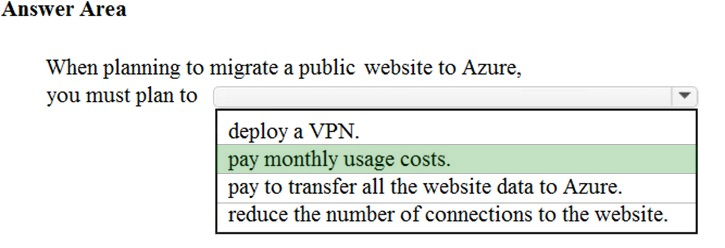
When planning to migrate a public website to Azure, you must plan to pay monthly usage costs. This is because Azure uses the pay-as-you-go model.
Question #41Topic 1
Note: This question is part of a series of questions that present the same scenario. Each question in the series contains a unique solution that might meet the stated goals. Some question sets might have more than one correct solution, while others might not have a correct solution.
After you answer a question in this section, you will NOT be able to return to it. As a result, these questions will not appear in the review screen.
Your company plans to migrate all its data and resources to Azure.
The company’s migration plan states that only Platform as a Service (PaaS) solutions must be used in Azure.
You need to deploy an Azure environment that meets the company migration plan.
Solution: You create an Azure App Service and Azure SQL databases.
Does this meet the goal?
- A. Yes
- B. No
Correct Answer: A
Azure App Service and Azure SQL databases are examples of Azure PaaS solutions. Therefore, this solution does meet the goal.
Community vote distribution
A (89%)
11%
Question #42Topic 1
Note: This question is part of a series of questions that present the same scenario. Each question in the series contains a unique solution that might meet the stated goals. Some question sets might have more than one correct solution, while others might not have a correct solution.
After you answer a question in this section, you will NOT be able to return to it. As a result, these questions will not appear in the review screen.
Your company plans to migrate all its data and resources to Azure.
The company’s migration plan states that only Platform as a Service (PaaS) solutions must be used in Azure.
You need to deploy an Azure environment that meets the company migration plan.
Solution: You create an Azure App Service and Azure virtual machines that have Microsoft SQL Server installed.
Does this meet the goal?
- A. Yes
- B. No
Correct Answer: A
Azure App Service is a PaaS (Platform as a Service) service. Azure virtual machines are an IaaS (Infrastructure as a Service) service, and a Paas service.
Therefore, this solution does meet the goal.
Note: Like IaaS, PaaS includes infrastructure”servers, storage, and networking”but also middleware, development tools, business intelligence (BI) services, database management systems, and more. PaaS is designed to support the complete web application lifecycle: building, testing, deploying, managing, and updating.
Reference:
https://azure.microsoft.com/en-us/overview/what-is-paas/
Community vote distribution
B (95%)
5%
Question #43Topic 1
Note: This question is part of a series of questions that present the same scenario. Each question in the series contains a unique solution that might meet the stated goals. Some question sets might have more than one correct solution, while others might not have a correct solution.
After you answer a question in this section, you will NOT be able to return to it. As a result, these questions will not appear in the review screen.
Your company plans to migrate all its data and resources to Azure.
The company’s migration plan states that only Platform as a Service (PaaS) solutions must be used in Azure.
You need to deploy an Azure environment that meets the company migration plan.
Solution: You create an Azure App Service and Azure Storage accounts.
Does this meet the goal?
- A. Yes
- B. No
Correct Answer: B
Community vote distribution
B (58%)
A (42%)
Question #44Topic 1
Your company hosts an accounting application named App1 that is used by all the customers of the company.
App1 has low usage during the first three weeks of each month and very high usage during the last week of each month.
Which benefit of Azure Cloud Services supports cost management for this type of usage pattern?
- A. high availability
- B. high latency
- C. elasticity
- D. load balancing
Correct Answer: C
Elasticity in this case is the ability to provide additional compute resource when needed and reduce the compute resource when not needed to reduce costs.
Autoscaling is an example of elasticity.
Elastic computing is the ability to quickly expand or decrease computer processing, memory and storage resources to meet changing demands without worrying about capacity planning and engineering for peak usage. Typically controlled by system monitoring tools, elastic computing matches the amount of resources allocated to the amount of resources actually needed without disrupting operations. With cloud elasticity, a company avoids paying for unused capacity or idle resources and doesn’t have to worry about investing in the purchase or maintenance of additional resources and equipment.
References:
https://azure.microsoft.com/en-gb/overview/what-is-elastic-computing/
Community vote distribution
C (94%)
6%
Question #45Topic 1
You plan to migrate a web application to Azure. The web application is accessed by external users.
You need to recommend a cloud deployment solution to minimize the amount of administrative effort used to manage the web application.
What should you include in the recommendation?
- A. Software as a Service (SaaS)
- B. Platform as a Service (PaaS)
- C. Infrastructure as a Service (IaaS)
- D. Database as a Service (DaaS)
Correct Answer: B
Azure App Service is a platform-as-a-service (PaaS) offering that lets you create web and mobile apps for any platform or device and connect to data anywhere, in the cloud or on-premises. App Service includes the web and mobile capabilities that were previously delivered separately as Azure Websites and Azure Mobile
Services.
References:
https://docs.microsoft.com/en-us/azure/security/fundamentals/paas-applications-using-app-services
Community vote distribution
B (79%)
A (21%)
Question #46Topic 1
HOTSPOT –
Which cloud deployment solution is used for Azure virtual machines and Azure SQL databases? To answer, select the appropriate options in the answer area.
NOTE: Each correct selection is worth one point.
Hot Area:
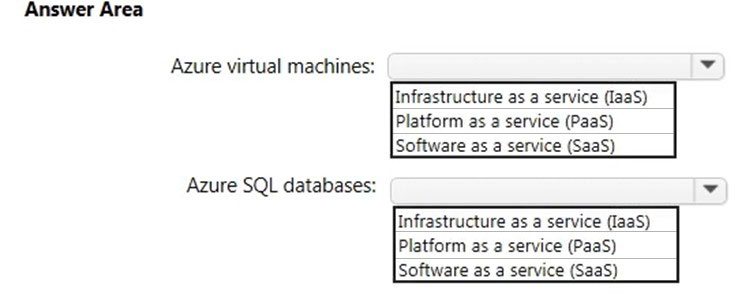
Correct Answer: 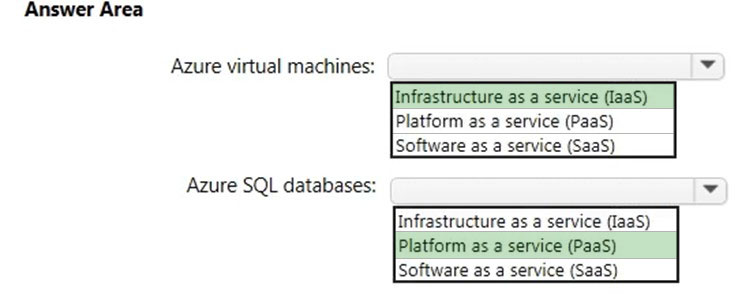
Box 1:
Azure virtual machines are Infrastructure as a Service (IaaS).
Infrastructure as a Service is the most flexible category of cloud services. It aims to give you complete control over the hardware that runs your application (IT infrastructure servers and virtual machines (VMs), storage, networks, and operating systems). Instead of buying hardware, with IaaS, you rent it.
Box 2:
Azure SQL databases are Platform as a Service (Paas).
Azure SQL Database is a fully managed Platform as a Service (PaaS) Database Engine that handles most of the database management functions such as upgrading, patching, backups, and monitoring without user involvement. Azure SQL Database is always running on the latest stable version of SQL Server
Database Engine and patched OS with 99.99% availability. PaaS capabilities that are built-in into Azure SQL database enable you to focus on the domain specific database administration and optimization activities that are critical for your business.
Reference:
https://docs.microsoft.com/en-gb/learn/modules/principles-cloud-computing/5-types-of-cloud-services https://docs.microsoft.com/en-us/azure/sql-database/sql-database-paas-index
Question #47Topic 1
You have an on-premises network that contains 100 servers.
You need to recommend a solution that provides additional resources to your users. The solution must minimize capital and operational expenditure costs.
What should you include in the recommendation?
- A. a complete migration to the public cloud
- B. an additional data center
- C. a private cloud
- D. a hybrid cloud
Correct Answer: D
A hybrid cloud is a combination of a private cloud and a public cloud.
Capital expenditure is the spending of money up-front for infrastructure such as new servers.
With a hybrid cloud, you can continue to use the on-premises servers while adding new servers in the public cloud (Azure for example). Adding new servers in
Azure minimizes the capital expenditure costs as you are not paying for new servers as you would if you deployed new server on-premises.
Incorrect Answers:
A: A complete migration of 100 servers to the public cloud would involve a lot of operational expenditure (the cost of migrating all the servers).
B: An additional data center would involve a lot of capital expenditure (the cost of the new infrastructure).
C: A private cloud is hosted on on-premises servers to this would involve a lot of capital expenditure (the cost of the new infrastructure to host the private cloud).
Reference:
https://docs.microsoft.com/en-gb/learn/modules/principles-cloud-computing/4-cloud-deployment-models
Community vote distribution
D (86%)
14%
Question #48Topic 1
HOTSPOT –
For each of the following statements, select Yes if the statement is true. Otherwise, select No.
NOTE: Each correct selection is worth one point.
Hot Area:

Correct Answer: 
Box 1: No –
It is not true that a company must always migrate from a private cloud model to implement a hybrid cloud. You could start with a public cloud and then combine that with an on-premise infrastructure to implement a hybrid cloud.
Box 2: Yes –
A company can extend the capacity of its internal network by using the public cloud. This is very common. When you need more capacity, rather than pay out for new on-premises infrastructure, you can configure a cloud environment and connect your on-premises network to the cloud environment by using a VPN.
Box 3: No –
It is not true that only guest users can access cloud resources. You can give anyone with an account in Azure Active Directory access to the cloud resources.
There are many authentication scenarios but a common one is to replicate your on-premises Active Directory accounts to Azure Active Directory and provide access to the Azure Active Directory accounts. Another commonly used authentication method is ‘Federation’ where authentication for access to cloud resources is passed to another authentication provider such as an on-premises Active Directory. https://azure.microsoft.com/en-gb/overview/what-is-hybrid-cloud-computing/
Question #49Topic 1
You plan to migrate several servers from an on-premises network to Azure.
What is an advantage of using a public cloud service for the servers over an on-premises network?
- A. The public cloud is owned by the public, NOT a private corporation
- B. The public cloud is a crowd-sourcing solution that provides corporations with the ability to enhance the cloud
- C. All public cloud resources can be freely accessed by every member of the public
- D. The public cloud is a shared entity whereby multiple corporations each use a portion of the resources in the cloud
Correct Answer: D
The public cloud is a shared entity whereby multiple corporations each use a portion of the resources in the cloud. The hardware resources (servers, infrastructure etc.) are managed by the cloud provider. Multiple companies create resources such as virtual machines and virtual networks on the hardware resources.
Incorrect Answers:
A: The public cloud is not owned by the public. In the case of Microsoft Azure, the cloud is owned by Microsoft.
B: The public cloud is a not crowd-sourcing solution. In the case of Microsoft Azure, the cloud is owned by Microsoft.
C: It is not true that public cloud resources can be freely accessed by every member of the public. You pay for a cloud subscription and create accounts for your users to access your cloud resources. No one can access your cloud resources until you create user accounts and provide the appropriate access permissions.
Community vote distribution
D (91%)
9%
Question #50Topic 1
HOTSPOT –
To complete the sentence, select the appropriate option in the answer area.
Hot Area:

Correct Answer: 
Azure Site Recovery helps ensure business continuity by keeping business apps and workloads running during outages. Site Recovery replicates workloads running on physical and virtual machines (VMs) from a primary site to a secondary location.
Reference:
https://docs.microsoft.com/en-us/azure/site-recovery/site-recovery-overview
Question #51Topic 1
In which type of cloud model are all the hardware resources owned by a third-party and shared between multiple tenants?
- A. private
- B. hybrid
- C. public
Correct Answer: C
Microsoft Azure, Amazon Web Services and Google Cloud are three examples of public cloud services.
Microsoft, Amazon and Google own the hardware. The tenants are the customers who use the public cloud services.
Community vote distribution
C (95%)
5%
Question #52Topic 1
HOTSPOT –
Select the answer that correctly completes the sentence.

Correct Answer: 
Question #53Topic 1
You have 1,000 virtual machines hosted on the Hyper-V hosts in a data center.
You plan to migrate all the virtual machines to an Azure pay-as-you-go subscription.
You need to identify which expenditure model to use for the planned Azure solution.
Which expenditure model should you identify?
- A. operational
- B. elastic
- C. capital
- D. scalable
Correct Answer: A
One of the major changes that you will face when you move from on-premises cloud to the public cloud is the switch from capital expenditure (buying hardware) to operating expenditure (paying for service as you use it). This switch also requires more careful management of your costs. The benefit of the cloud is that you can fundamentally and positively affect the cost of a service you use by merely shutting down or resizing it when it’s not needed.
Reference:
https://docs.microsoft.com/en-us/azure/architecture/cloud-adoption/appendix/azure-scaffold
Community vote distribution
A (100%)
Question #54Topic 1
DRAG DROP –
Match the Azure services benefits to the correct descriptions.
Instructions: To answer, drag the appropriate benefit from the column on the left to its description on the right. Each benefit may be used once, more than once, or not at all.
NOTE: Each correct match is worth one point.
Select and Place:

Correct Answer: 
Box 1:
Fault tolerance is the ability of a service to remain available after a failure of one of the components of the service. For example, a service running on multiple servers can withstand the failure of one of the servers.
Box 2:
Disaster recovery is the recovery of a service after a failure. For example, restoring a virtual machine from backup after a virtual machine failure.
Box 3:
Dynamic scalability is the ability for compute resources to be added to a service when the service is under heavy load. For example, in a virtual machine scale set, additional instances of the virtual machine are added when the existing virtual machines are under heavy load.
Box 4:
Latency is the time a service to respond to requests. For example, the time it takes for a web page to be returned from a web server. Low latency means low response time which means a quicker response.
References:
https://msdn.microsoft.com/en-us/magazine/mt422582.aspx
https://searchdisasterrecovery.techtarget.com/definition/cloud-disaster-recovery-cloud-DR http://www.siasmsp.com/the-benefit-of-scalability-in-cloud-computing-2/ https://azure.microsoft.com/en-in/overview/what-is-cloud-computing/
Question #55Topic 1
HOTSPOT –
For each of the following statements, select Yes if the statement is true. Otherwise, select No.
NOTE: Each correct selection is worth one point.
Hot Area:

Correct Answer: 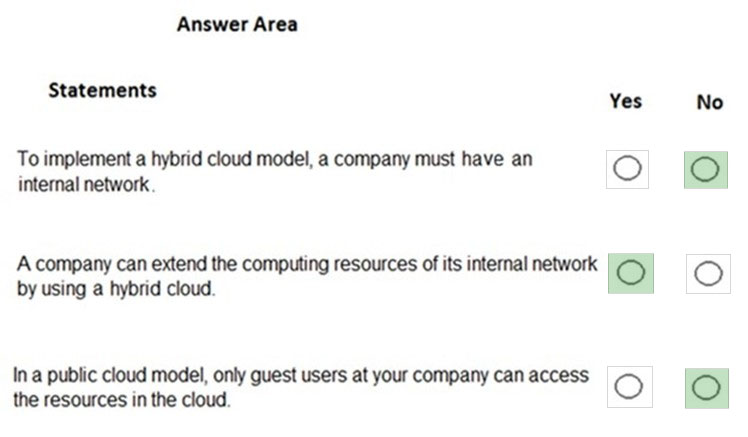
Box 1: No –
It is not true that a company must always migrate from an internal network to implement a hybrid cloud. You could start with a public cloud and then combine that with an on-premise infrastructure to implement a hybrid cloud.
Box 2: Yes –
A company can extend the computing resources of its internal network by using the public cloud. This is very common. When you need more resources, rather than pay out for new on-premises infrastructure, you can configure a cloud environment and connect your on-premises network to the cloud environment by using a VPN.
Box 3: No –
It is not true that only guest users can access cloud resources. You can give anyone with an account in Azure Active Directory access to the cloud resources.
There are many authentication scenarios but a common one is to replicate your on-premises Active Directory accounts to Azure Active Directory and provide access to the Azure Active Directory accounts. Another commonly used authentication method is ‘Federation’ where authentication for access to cloud resources is passed to another authentication provider such as an on-premises Active Directory.
Reference:
https://azure.microsoft.com/en-gb/overview/what-is-hybrid-cloud-computing/
Question #56Topic 1
HOTSPOT –
For each of the following statements, select Yes if the statement is true. Otherwise, select No.
NOTE: Each correct selection is worth one point.
Hot Area:
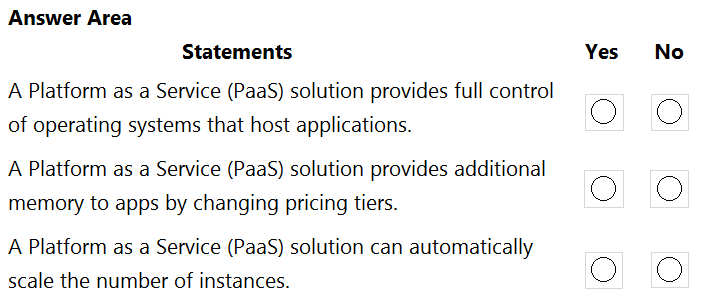
Correct Answer: 
Question #57Topic 1
Your company has an on-premises network that contains multiple servers.
The company plans to reduce the following administrative responsibilities:
✑ Backing up application data
✑ Replacing failed server hardware
✑ Managing physical server security
✑ Updating server operating systems
✑ Managing permissions to shared documents
The company plans to migrate servers to Azure virtual machines.
You need to identify which administrative responsibilities will be eliminated after the planned migration.
Which two responsibilities should you identify? Each correct answer presents a complete solution.
NOTE: Each correct selection is worth one point.
- A. Replacing failed server hardware
- B. Backing up application data
- C. Managing physical server security
- D. Updating server operating systems
- E. Managing permissions to shared documents
Correct Answer: AC
Azure virtual machines run on Hyper-V physical servers. The physical servers are owned and managed by Microsoft. As an Azure customer, you have no access to the physical servers. Microsoft manage the replacement of failed server hardware and the security of the physical servers so you don’t need to.
Incorrect Answers:
B: Microsoft have no control over the applications you run on the virtual machines. Therefore, it is your responsibility to ensure that application data is backed up.
D: Microsoft do not manage the operating systems you run on the virtual machines. Therefore, it is your responsibility to ensure that the operating systems are updated.
E: Microsoft have no control over the shared folders you host on the virtual machines. Therefore, it is your responsibility to ensure that folder permissions are configured appropriately.
Community vote distribution
AC (95%)
Question #58Topic 1
HOTSPOT –
For each of the following statements, select Yes if the statement is true. Otherwise, select No.
NOTE: Each correct selection is worth one point.
Hot Area:

Correct Answer: 
One of the major changes that you will face when you move from on-premises cloud to the public cloud is the switch from capital expenditure (buying hardware) to operating expenditure (paying for service as you use it).
Box 1: No –
With the pay-as-go model, you pay for services as you use them. This is Opex (Operational Expenditure), not CapEx (Captial Expenditure). CapEx is where you pay for something upfront. For example, buying a new physical server.
Box 2: No –
Paying for electricity for your own datacenter will be classed as CapEx, not OpEx.
Box 3: Yes –
Deploying your own datacenter is an example of CapEx. This is because you need to purchase all the infrastructure upfront before you can use it.
Reference:
https://docs.microsoft.com/en-us/azure/architecture/cloud-adoption/appendix/azure-scaffold
Question #59Topic 1
You plan to provision Infrastructure as a Service (IaaS) resources in Azure.
Which resource is an example of IaaS?
- A. an Azure web app
- B. an Azure virtual machine
- C. an Azure logic app
- D. an Azure SQL database
Correct Answer: B
An Azure virtual machine is an example of Infrastructure as a Service (IaaS).
Azure web app, Azure logic app and Azure SQL database are all examples of Platform as a Service (Paas).
Reference:
https://azure.microsoft.com/en-gb/overview/what-is-iaas/
https://azure.microsoft.com/en-gb/overview/what-is-paas/
Community vote distribution
B (100%)
Question #60Topic 1
To which cloud models can you deploy physical servers?
- A. private cloud and hybrid cloud only
- B. private cloud only
- C. private cloud, hybrid cloud and public cloud
- D. hybrid cloud only
Correct Answer: A
A private cloud is on-premises so you can deploy physical servers.
A hybrid cloud is a mix of on-premise and public cloud resources. You can deploy physical servers on-premises.
Reference:
https://azure.microsoft.com/en-gb/overview/what-is-hybrid-cloud-computing/
Community vote distribution
A (100%)

